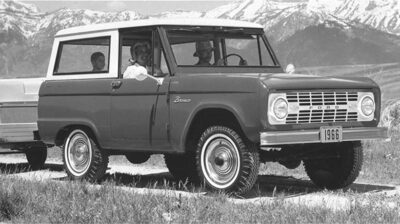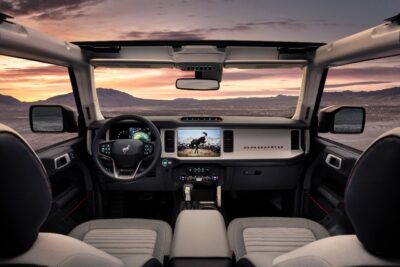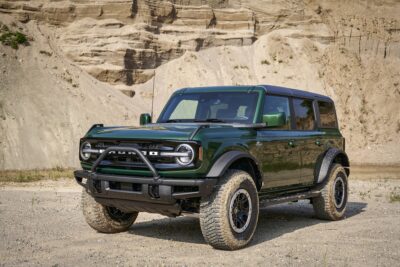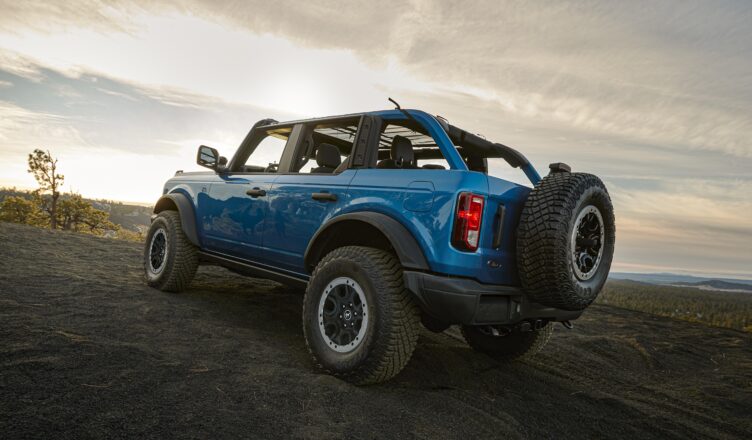Over the river, through the woods, or just across open Interstate, the 2024 Ford Bronco Big Bend is ready for adventure. Whether bounding over rough trails to a lake cabin, gobbling up potholes on the way to work, or soaking up long miles to grandma’s house, the big bad Ford delivers.
It looks the part too. Styling is lifted from the original 1966-1977 model designed by Donald Frey. That means round LED headlamps, wide flat hood with tie-downs at the front corners, exposed tow hooks, and white BRONCO spelled across a plastic reincarnation of the classic truck’s steel grille. Check the 17” beadlock alloy wheels with off-road tires. Base models wear a canvas top, but ours has removable roof panels that allow owners to remove just a couple over the front or completely strip down on warm days.
And whether you’re looking forward to summer, or just trying to survive winter, the Bronco’s interior is sublime. It’s pretty basic with rubber floormats, passenger side drain plug and removable doors, but contrasting color plastic, heated marine-grade vinyl seats, and dual-zone automatic climate control add upscale amenities. The flatscreen instrument cluster with digital speedometer and bar graph tach accompany a picture-size center screen for intuitively controlling audio, phone, and apps. Connect wirelessly via Apple CarPlay and Android Auto.
Stay safe with automatic emergency braking, blind spot warning, lane keep assist, rear cross traffic alert and rear child reminder.
The Bronco seems kinda big, so I was curious how it matched up with classic Broncos. In virtually every dimension, the short- and long-wheelbase Ranger-based 2024 Broncos straddle the 1980s/90s F-150 based Broncos. The smaller Escape-based Bronco Sport is larger in every dimension compared to the ‘80s Ranger-based Bronco II. Trucks have grown, but our Bronco would have been very full-size thirty years ago.
On the road, though, it doesn’t feel as big as its ancestors. Its tight turning radius allow for maneuverability on trails…and in snug parking garages.
I drove across potholed city streets and several hours on the Interstate through Indiana to visit relatives. The long wheelbase, fat tires, wide track, and independent front suspension imbue a far more comfortable ride than you probably imagine. Sure, it’s stiffly sprung for serious no-roading, but is comfortable enough for long drives. There’s plenty of wind noise, and the roof panels creak, so I cranked the stereo up to ignore them.
Bear a heavy foot and you’ll wish for the road-going equivalent of aerial refueling. EPA economy rates just 18/17-MPG city/highway. It’s a big tall brick with fat tires – no recipe for frugal driving. At least the 2.3-liter turbo-four delivers a delightful 300 horsepower and 325 lb.-ft. of torque that makes the Bronco seem lighter than it is. Choose the optional 10-speed automatic transmission for daily use.

For more capability than I’ll ever need, our Big Bend edition came with locking front/rear differentials and G.O.A.T modes (Goes Over Any type of Terrain) that configures the powertrain for sand, snow, mud, or virtually any other condition. A fully-framed full-size SUV boasting 300 horsepower should be able to tow more than the 3,500 lbs. for which our Bronco is rated.
Ford kept the Bronco’s heritage intact while advancing it for todays needs. It’s comfortable, but still capable; rugged, but digitally connected. Compared to an old Bronco’s inflation-adjusted price, the current one is a better deal with prices starting at $39,630 and bounding to $55,915 all-in. Even better, it’s assembled at Ford’s Wayne, Michigan Assembly Plant where all full-size Broncos have emerged since 1966. Competitors include the Jeep Wrangler, Chevy Tahoe, Toyota Land Cruiser, and Land Rover Defender.
Storm Forward!
Send comments to Casey at AutoCasey@aol.com; follow him on YouTube @AutoCasey.
